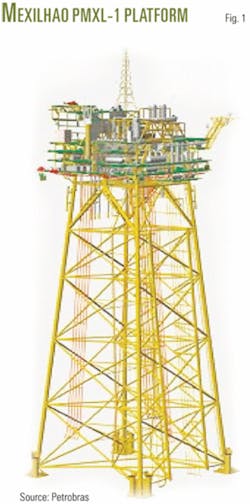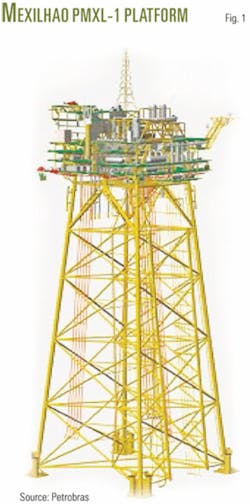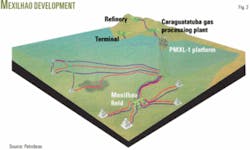The Mexilhao nonassociated gas development in the Santos basin includes the largest fixed platform to date off Brazil.
Petroleo Brasileiro SA (Petrobras) plans to install the 230-m tall PMXL-1 platform in 172 m of water (Fig. 1). The platform has a 182-m jacket.
The company expects the field to go on stream in 2009, with full production starting in 2010 or 2011. The platform will have a capacity to produce and treat about 15 million cu m/day of gas and 3,200 cu m/day of condensate.
Petrobras plans to market the gas in southern and southeastern Brazil, regions that have the largest industrial parks in the country.
Mexilhao field
Mexilhao field is in Block BS-400 of the Santos basin, about 140-km from the coast. Petrobras discovered the field in 2003.
Petrobras says the reservoirs in Mexilhao field are different from those encountered in the Campos basin. The reservoirs have high temperatures and pressures, are at 5,000-6,000 m depths, and have low permeability.
Field development includes subsea-completed gas wells drilled in 320-550 m of water and tied back about 20 km to the platform (Fig. 2).
Development calls for installing subsea production systems that separate produced water at the seafloor and reinject it into nearby reservoirs. Another feature of the development plan is the injection of monoethylene glycol (MEG) into the wells to prevent formation of hydrates that could block flow lines.
The development also will process the gas at high pressure on the platform, thereby eliminating the need for installing export compressors.
A 145-km, 34-in. pipeline will transport the produced gas to a gas processing plant in Caraguatatuba, in the Brazilian state of Sao Paulo. From there, another 100-km pipeline will move the gas to Taubate, where the pipeline connects to the Campinas-Rio de Janeiro pipeline.
Petrobras estimates that the Mexilhao project will require an investment of more than $2 billion.
Mexilhao, the Portuguese word for clam, is a type of mussel served as seafood.
Santos basin
In the Santos basin, Petrobras currently produces about 1 million cu m of gas and 1,600 bo/d from Merluza field, a field discovered in the 1980s and put on stream in 1993.
Petrobras has initiated a Santos basin natural gas and oil production development master plan that expects to invest about $18 billion in the next 10 years (OGJ, Nov. 20, 2006, p. 43). The company’s forecast shows that gas production from the basin may reach 30 million cu m/day by 2011 and oil production may increase in the next 4-5 years to 100,000 b/d from the current 10,000 b/d.
Petrobras plans to integrate the Mexilhao development with currently producing Merluza and Coral fields. This plan includes the building of a gas-treatment plant in Caraguatatuba. It initially will have two modules, each capable of processing 7.5 million cu m/day of gas produced from Mexilhao, Cedro, and other Santos basin fields.
From the Merluza area Petrobras expects additional gas production of 8 million cu m/day of gas and 25,000 b/d of oil and condensate after installation of the Merluza-2 platform. This additional gas production will require expansion of the Caraguatatuba gas processing capacity to 22.5 million cu m/day.
Another expected production increase from the Santos basin is from the interlinking of Lagosta field and the SPS-25 area with the Merluza system. This work will increase natural gas production to 2.5 million cu m/day from the basin by 2008.
Petrobras also estimates discoveries in the BS-500 development, including Urugua and Tambau fields, may produce 20 million cu m/day and 150,000-200,000 bo/d.
Another region from which Petrobras expects additional production is the Southern area that includes the Coral platform, in Parana. The field currently produces about 9,000 bo/d.
In the Southern area, Petrobras expects Cavalo-Marinho field to go on line in 2008 with production similar to the Coral platform and other new projects eventually producing 140,000 bo/d and 3 million cu m/day of gas.




